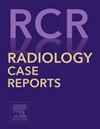黄色肉芽肿性输卵管卵巢炎的磁共振成像表现1例
Q4 Medicine
引用次数: 0
摘要
黄色肉芽肿性输卵管卵巢炎是一种非常罕见的疾病,可与附件恶性肿瘤混淆。很少有报道描述这种疾病的弥散加权成像特征。一名56岁妇女腹痛,被转介到我们医院。磁共振成像显示左侧附件肿块延伸至子宫和直肠。脂肪饱和t1加权增强图像显示肿块实性部分对比度增强。该成分在扩散加权图像上表现为低密度,在表观扩散系数图上不表现为扩散受限。术前考虑附件恶性肿瘤的可能性,因为肿块已扩散到周围器官。患者接受手术,术后病理诊断为黄色肉芽肿性输卵管卵巢炎。虽然扩展到周围器官的黄色肉芽肿性输卵管卵巢炎可能与附件恶性肿瘤相混淆,但肿块的造影增强部分没有扩散受限可以帮助正确的术前诊断并减少根治性手术。本文章由计算机程序翻译,如有差异,请以英文原文为准。
Magnetic resonance imaging findings of xanthogranulomatous salpingo-oophoritis: A case report
Xanthogranulomatous salpingo-oophoritis is an extremely rare disease that can be confused with adnexal malignancy. Few reports have described the diffusion-weighted imaging features of this disease. A 56-year-old woman presented with abdominal pain and was referred to our hospital. Magnetic resonance imaging showed a left adnexal mass extending to the uterus and the rectum. The solid component of the mass showed intense contrast enhancement on contrast-enhanced fat-saturated T1-weighted image. The component showed hypointensity on diffusion-weighted image and did not show restricted diffusion on the apparent diffusion coefficient map. The possibility of a malignant adnexal tumor was considered preoperatively because the mass had extended to the surrounding organs. The patient underwent surgery, and the postoperative pathological diagnosis was xanthogranulomatous salpingo-oophoritis. Although xanthogranulomatous salpingo-oophoritis extending to the surrounding organs may be confused with adnexal malignancy, the contrast-enhanced component of the mass without restricted diffusion could aid in the correct preoperative diagnosis and lead to less radical surgery.
求助全文
通过发布文献求助,成功后即可免费获取论文全文。
去求助
来源期刊

Radiology Case Reports
Medicine-Radiology, Nuclear Medicine and Imaging
CiteScore
1.10
自引率
0.00%
发文量
1074
审稿时长
30 days
期刊介绍:
The content of this journal is exclusively case reports that feature diagnostic imaging. Categories in which case reports can be placed include the musculoskeletal system, spine, central nervous system, head and neck, cardiovascular, chest, gastrointestinal, genitourinary, multisystem, pediatric, emergency, women''s imaging, oncologic, normal variants, medical devices, foreign bodies, interventional radiology, nuclear medicine, molecular imaging, ultrasonography, imaging artifacts, forensic, anthropological, and medical-legal. Articles must be well-documented and include a review of the appropriate literature.
 求助内容:
求助内容: 应助结果提醒方式:
应助结果提醒方式:


